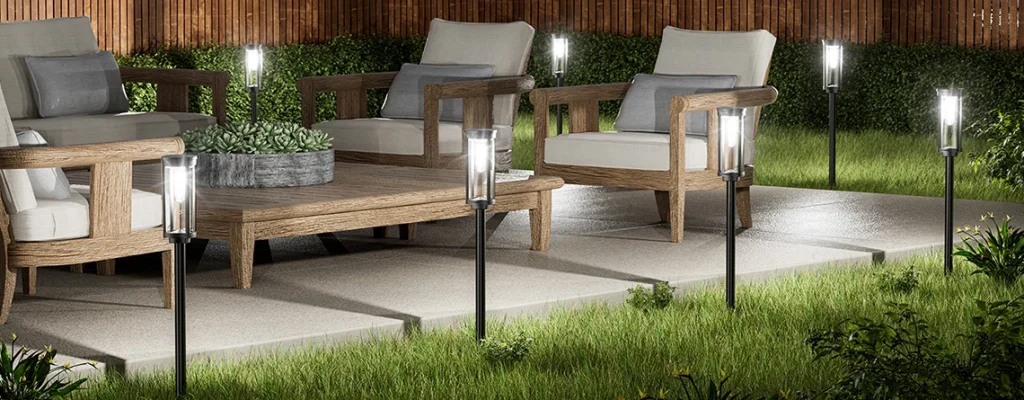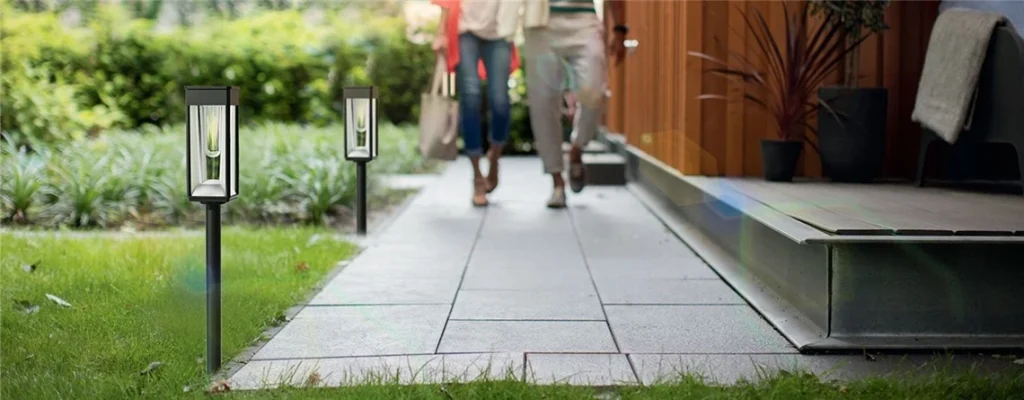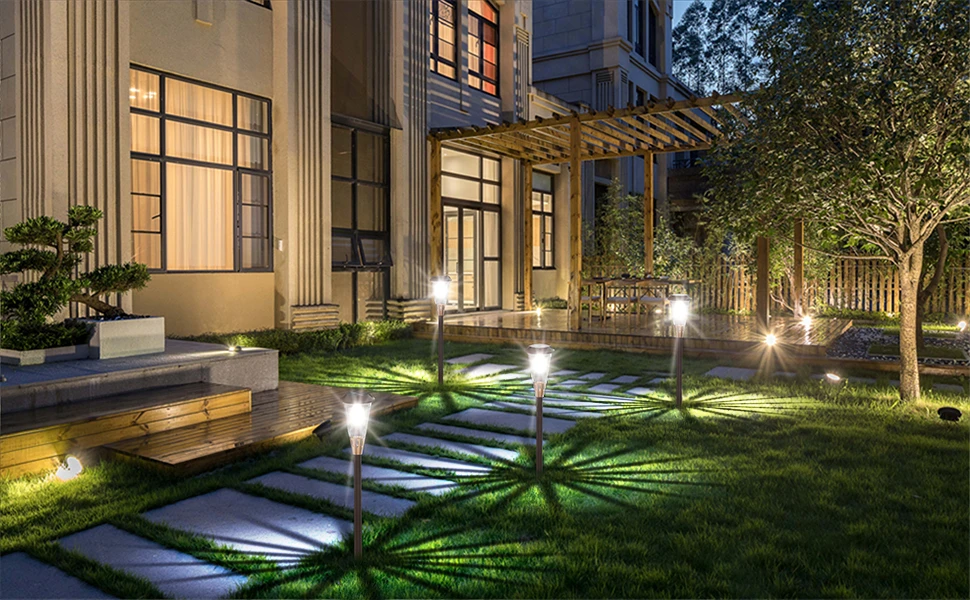The best solar path lights for shady areas are designed to bring eco-friendly, reliable illumination to outdoor spaces with limited sunlight, such as gardens under trees, shaded walkways, or north-facing yards. These lights harness solar energy efficiently, even in low-light conditions, to provide safety and aesthetic appeal without high electricity costs. Search trends reveal that users are keen to understand how these lights perform in shade, their brightness, durability, battery life, and cost-effectiveness. This article explores the top features, benefits, and a curated ranking of the best solar path lights for shady areas, including standout options like BITPOTT’s solar pathway lights, while addressing user concerns and offering practical tips for maximizing performance.

Why Choose the Best Solar Path Lights for Shady Areas?
Challenges of Solar Lighting in Shady Areas
Solar path lights rely on sunlight to charge their batteries, but shaded areas—under trees, near buildings, or in cloudy climates—reduce charging efficiency. Users often search for lights that can function with minimal direct sunlight, a concern echoed in forums like Reddit, where users report standard solar lights lasting only a few hours in shade. The best solar path lights for shady areas address this by using high-efficiency solar panels, larger batteries, or separate panels that can be placed in sunnier spots.
Benefits of Solar Path Lights for Shady Areas
- Eco-Friendly and Cost-Saving: These lights eliminate electricity costs and reduce your carbon footprint. BITPOTT’s s solar lights, for example, use monocrystalline silicon panels for efficient charging, even in partial shade.
- Enhanced Safety: Illuminating shaded pathways prevents tripping hazards, a key user concern for walkways and gardens.
- Aesthetic Appeal: With designs like BITPOTT’s s retro tungsten filament bulbs, these lights add charm to low-light areas, creating inviting patterns or color-changing effects.
- Low Maintenance: No wiring or professional installation is needed, making them DIY-friendly, as noted by Sarah Jameson of Green Building Elements.
Key Features to Look for in the Best Solar Path Lights for Shady Areas
Based on user searches and reviews from sources like The Spruce and HGTV, here are critical features to prioritize:
- High-Efficiency Solar Panels: Monocrystalline panels, like those in BITPOTT’s s lights, charge faster than amorphous silicon, even in indirect light.
- Large-Capacity Batteries: Batteries with 450mAh or higher (e.g., BITPOTT’s s 3.7V/1.85WH) ensure longer runtime, crucial for shady areas.
- Separate Solar Panels: Lights like T-SUNUS spotlights allow panels to be placed in sunlit areas while lights illuminate shaded spots.
- Weather Resistance: An IP65 or higher rating ensures durability in rain, snow, or frost. BITPOTT’s s IP67-rated lights are praised for withstanding harsh weather.
- Brightness (Lumens): For pathways, 10-50 lumens is sufficient, but 100-200 lumens, as seen in T-SUNUS models, is ideal for brighter illumination.
- Adjustable Settings: Lights with brightness modes or on/off switches, like URPOWER’s, allow customization for shade conditions.
Top 5 Best Solar Path Lights for Shady Areas in 2025
Drawing from user reviews, testing insights from The Spruce, HGTV, and Amazon, here’s a ranking of the best solar path lights for shady areas, including BITPOTT’s cost-effective option.
1. T-SUNUS Solar-Powered LED Spotlights (2-Pack)
- Price: ~$35-$45
- Lumens: 10-25 lumens (adjustable)
- Battery Life: 8-18 hours (low mode), 8-10 hours (high mode)
- Weather Resistance: IP65
- Features: Separate solar panel with 10-ft cord, two brightness modes, adjustable panel and light heads
- Why It Ranks #1: T-SUNUS lights excel in shady areas due to their separate solar panel, which can be placed in direct sunlight while lights illuminate shaded spots. Users on Amazon praise their flexibility for gardens and patios, with one noting, “Perfect for my shaded walkway—bright and reliable!” The adjustable brightness and IP65 rating ensure versatility, though the 10-ft cord may limit placement.
2. BITPOTT Bright Solar Pathway Lights (8-Pack)
- Price: ~$30-$40 (often discounted with codes like AOSEA5024)
- Lumens: Up to 55 lumens
- Battery Life: 8-14 hours
- Weather Resistance: IP65/IP67
- Features: Monocrystalline silicon panels, warm white or color-changing modes, retro tungsten filament design
- Why It Ranks: BITPOTT’s lights are a budget-friendly, high-performing option for shady areas. Their efficient panels charge well in partial shade, and the high-lumen output ensures bright illumination. Users appreciate the durable IP67 rating and easy stake installation, though some report shorter runtimes (4-6 hours) in full shade.
3. URPOWER Solar Lights Outdoor (8-Pack)
- Price: ~$30
- Lumens: 10-20 lumens
- Battery Life: 8-10 hours
- Weather Resistance: IP65
- Features: Two brightness settings, stake or wall-mount options, adjustable solar panels
- Why It Ranks: URPOWER’s lights are versatile for shady areas, with adjustable panels to optimize charging. HGTV’s tests confirm their durability, surviving water and impact tests. Users value their dual placement options, though they’re less bright than BITPOTT’s.
4. XMCOSY+ Solar Pathway Lights (6-Pack)
- Price: ~$40-$50
- Lumens: 10-25 lumens
- Battery Life: 8-12 hours
- Weather Resistance: IP65
- Features: Stainless steel construction, warm white glow, diamond-patterned shades
- Why It Ranks: XMCOSY+ lights offer a stylish design with durable materials, ideal for shaded gardens. Their larger solar panels perform well in partial shade, as noted in user reviews. However, they’re pricier than BITPOTT’s and lack color-changing options.
5. WdtPro Solar Pathway Lights (6-Pack)
- Price: ~$19-$25 (with promo code YHFTJCG4)
- Lumens: 15-20 lumens
- Battery Life: 6-10 hours
- Weather Resistance: IP65
- Features: Warm white LEDs, simple design, easy installation
- Why It Ranks: WdtPro’s lights are the most affordable, with decent performance in partial shade. Users on X highlight their value with discounts, but they’re less durable than BITPOTT’s in extreme weather.
How to Choose the Best Solar Path Lights for Shady Areas
Evaluate Sunlight Exposure
Users often ask how solar lights perform in shade. While no solar light thrives in full shade, models like T-SUNUS with separate panels or BITPOTT with efficient monocrystalline panels work well in partial shade (Shade-1 category, where the sky is visible but direct sun is blocked). Avoid placing panels under dense foliage or near artificial lights that may trigger sensors.
Prioritize Battery and Panel Efficiency
Battery capacity and panel type are critical for shady areas. Look for high-capacity batteries (450mAh or more) and monocrystalline panels, as used in BITPOTT and T-SUNUS models. USB charging, as offered by NESENNI lights, is a bonus for cloudy days.
Check Weather Resistance
Shady areas often retain moisture, so an IP65 or higher rating is essential. BITPOTT’s IP67-rated lights and T-SUNUS’s IP65 spotlights are top choices, with users reporting reliability in rain and snow.
Consider Brightness and Design
For safety, choose lights with 10-50 lumens for pathways or 100-200 lumens for spotlights, as recommended by Real Simple. BITPOTT’s color-changing options add aesthetic versatility, while XMCOSY+’s patterned shades create decorative effects.

Installation and Maintenance Tips for the Best Solar Path Lights for Shady Areas
Installation Steps
- Optimize Panel Placement: For lights like T-SUNUS, place the separate solar panel in a sunny spot, up to 10 feet from the light. For BITPOTT’s integrated panels, choose areas with partial sunlight (Shade-1).
- Activate the Switch: Turn on the light before installation, typically via a switch under the panel. BITPOTT’s external switch is user-friendly.
- Secure Stakes: Insert stakes firmly into soft soil. For hard ground, use a mallet or pre-drill holes to avoid breaking plastic stakes, as noted for GIGALUMI’s lights.
- Test in Darkness: Cover the panel to ensure lights activate, confirming functionality.
Maintenance for Optimal Performance
- Clean Panels Regularly: Remove dirt, snow, or leaves from panels with a damp cloth to maximize charging, especially in shady areas.
- Replace Batteries: Check batteries every 3-4 years. BITPOTT’s replaceable AA batteries simplify maintenance.
- Store in Extreme Conditions: While IP65/IP67 lights are durable, storing them during severe winters can extend lifespan, as suggested in Reddit discussions.
- Use Clear Coatings: Some users apply clear nail polish or spar varnish to panels to restore clarity, though results vary.
Addressing Common User Questions About the Best Solar Path Lights for Shady Areas
Do Solar Lights Work in Shady Areas?
Yes, but performance depends on the shade level. T-SUNUS’s separate panels ensure charging in full shade, while BITPOTT’s efficient panels work in partial shade. In full shade, expect 4-6 hours of runtime versus 8-12 hours in sun.
How Bright Are These Lights?
Brightness ranges from 10-55 lumens for path lights (BITPOTT, URPOWER) to 100-200 lumens for spotlights (T-SUNUS). Users find these sufficient for pathways, though spotlights are better for larger areas.
Are They Durable in Harsh Weather?
IP65/IP67-rated lights, like BITPOTT’s and T-SUNUS’s, withstand rain, snow, and frost. Amazon reviews confirm BITPOTT’s reliability in stormy conditions.
How Easy Are They to Install?
Most lights, including BITPOTT and URPOWER, require no tools—just stake into the ground. T-SUNUS’s corded panels need strategic placement but are equally simple.
Why BITPOTT Shines Among the Best Solar Path Lights for Shady Areas
BITPOTT’s 8-pack solar pathway lights are a standout for their affordability and performance in partial shade. Key features include:
- High Brightness: Up to 55 lumens, ideal for pathways.
- Efficient Charging: Monocrystalline panels charge in 4-8 hours, even in low light.
- Durable Design: IP67 rating and thick lampshades ensure longevity.
- Versatile Modes: Warm white or color-changing options enhance aesthetics.
Users praise their brightness and ease of use, with one stating, “These lights brighten my shaded garden beautifully!” Some note reduced runtime in full shade, but maintenance tips like panel cleaning help.
Creative Uses for the Best Solar Path Lights for Shady Areas
- Shaded Garden Accents: Place BITPOTT or XMCOSY+ lights among flowerbeds to highlight plants, casting decorative patterns.
- Tree-Lined Pathways: Use T-SUNUS spotlights with separate panels to illuminate walkways under dense foliage.
- Patio Enhancements: Combine BITPOTT’s color-changing lights with solar lanterns for a layered, festive look during events.
- Driveway Markers: URPOWER’s stake or wall-mount options guide vehicles safely in shaded driveways.
Conclusion
The best solar path lights for shady areas, like T-SUNUS, BITPOTT, and URPOWER, offer reliable, eco-friendly illumination for low-light landscapes. By prioritizing efficient panels, high-capacity batteries, and durable designs, these lights address user concerns about performance in shade. With proper placement and maintenance, they provide safety, beauty, and cost savings. Whether for pathways, gardens, or patios, these lights are a smart choice for transforming shaded outdoor spaces.


Leave a Reply